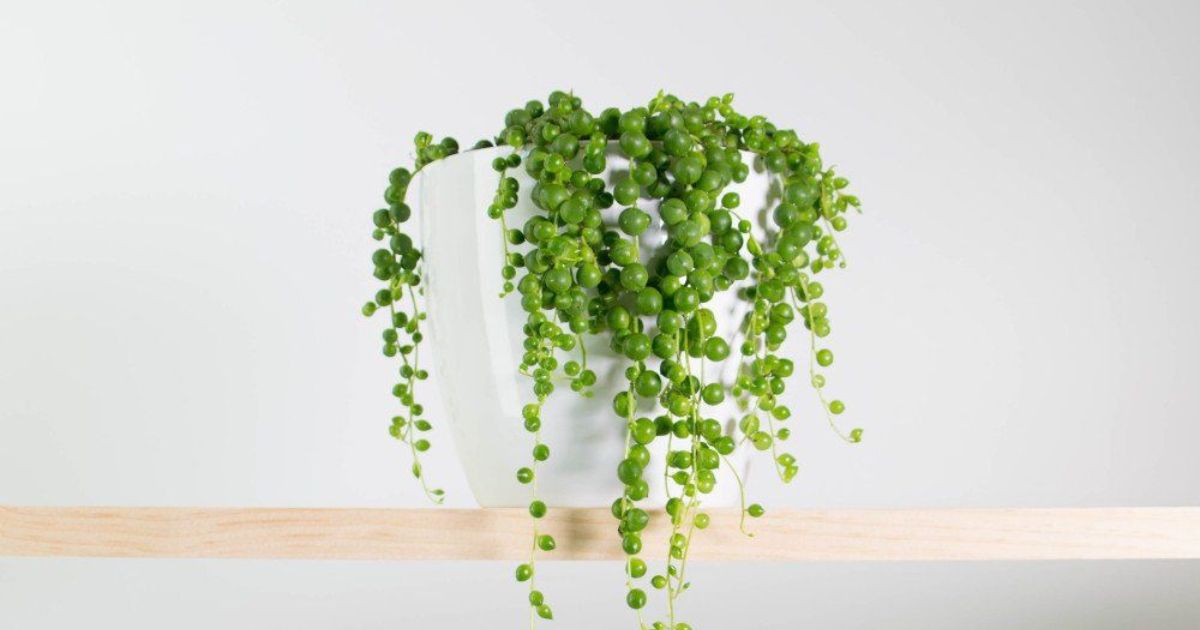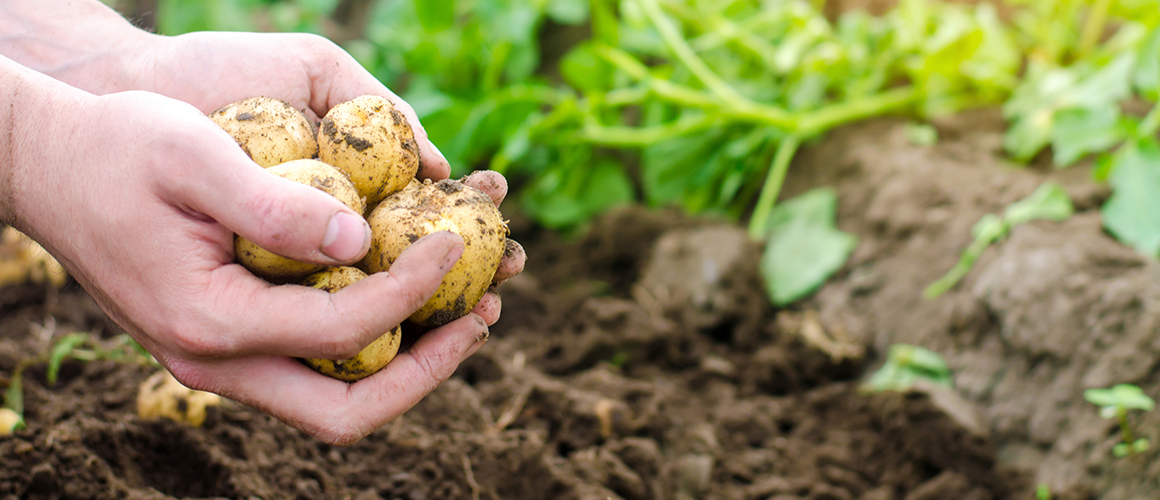String of Pearls: Senecio Rowleyanus is a lovely, cascading succulent that will add a strange touch to any home. It’s like a string of pearls. The Plant can be grown both outdoors and indoors, grows quickly, and spreads readily. Senecio Rowleyanus Strings of Pearls is a stunning succulent that grows well if you’re looking for something spectacular. In order to properly take care of String of Pearls, there are a few things you should know.
Senecio rowleyanus, sometimes called Curio rowleyanus or the String-of-pearls, is a succulent that is adored for its enchanting, spherical leaves and trailing vines. This species requires little upkeep and looks fantastic in a hanging planter because of its flowing vines, which give any area a distinctive texture. Everything you need to know about caring for a String of pearl plants at home will be covered in this article, including planting and potting techniques, the ideal soil mixture, light, temperature, and humidity considerations, and crucial fertilization, pruning, and propagation advice.

What is a String of Pearls Plant?
The String of Pearls succulent has a very distinctive appearance and is very popular among people who appreciate how simple it is to take care of in addition to its attractiveness! The leaves, which resemble bubbles or pearls, look amazing hanging over a basket or a bookshelf. Similar to other How to Grow Lemongrass succulents, there are a few tips to ensure the happy survival of these plants. However, with some experience, you can easily assist this Plant in thriving!
These plants happily root as a groundcover in the South West African deserts where they are native. They spread their roots and vines throughout the desert, thriving even in areas with very little water. They have evolved to fit this environment, which is why their leaves have such an unusual shape and resemble bubbles. Their “pearls” are used to store water, and the shape reduces the amount of leaf surface area to avoid excessive evaporation and water loss.
Is String of Pearls rare?
When a succulent has leaves that differ from the typical green color in terms of pattern or color, it is said to be varied. It may be the result of a genetic mutation that alters the production of chlorophyll or the presence of distinct pigments in the Plant’s leaves. Because of their distinctive look, variegated succulents—like this variegated String-of-pearls—are prized by collectors and gardeners as rare and desirable plants.

The String of Pearls Plant Care Basics
If this is your first knowledge of this type of Plant, don’t worry. Plantly will lead the way the entire time. First and foremost, it’s critical to understand the general principles of the String-of-pearls’ primary care advice. Here is a brief synopsis of it.
Other names: Bead necklace, rosary plant
Plant type: Climbing plant, Houseplant, Succulent
Exposure to sunlight: Bright indirect light, can tolerate reasonable direct light
Soil type: Porous, Sandy, Rocky
Green color
Water: Moderate
Favorable temperature: 70° – 80°Fahrenheit (21 – 26.6°Celsius)
Preferable fertilizer: Fine and coarse gravel containing phosphorus.
Propagation: stem cuttings
Toxicity Warning: Toxic to humans and pets
Height for mature plants: 1-2 feet
Origin: Southwest Africa
Keep going! Now that you have a summary of the String of Pearls care let’s learn more tips on how to take care of it efficiently.

String of Pearls Care
The String of Pearls care plant doesn’t care about the environment. With sufficient light and fertilizer, it can grow quickly throughout the season. If given adequate care, a single plant can live for approximately five years; however, if new plants are propagated from stem cuttings, the Plant’s lifespan can be practically extended to infinity.
Consider growing a string of pearls in a hanging basket with multiple stems to let this Plant shine. It can form a terrestrial mat similarly to how it does in the wild by interlacing its branches and growing it in a dish. A string of pearls doesn’t need much maintenance and doesn’t have any serious disease issues. But it does require a lot of light throughout the year.
Light
String of Pearls plants thrive in a combination of direct and indirect sunlight, totaling between six and eight hours a day. It is best to keep them in direct sunlight during the milder hours of the morning and then move them to a location that receives diffuse, indirect light or partial shade during the harsher hours of the afternoon.
Floor
Any regular succulent potting soil is acceptable for your pearl necklace plants, but sandy soil is best. A good option for this Plant is a cactus potting mix. Alternatively, you can use a three-to-one mixture of potting soil and sharp sand. These plants are susceptible to root rot, so make sure your soil has good drainage. They plant them in a container that has ample drainage holes at its base. Terracotta or clay pots can also help remove excess moisture from the soil.
Water
Keep the Plant’s soil slightly moist during the spring and summer growing seasons, then reduce the water during the winter months. If you notice the spherical leaves of your succulent becoming flattened, it is a good indicator that the Plant needs more water. You will probably need to water your Plant once every seven to 14 days. Plants in warmer climates, outdoors during the summer, or in porous terracotta pots may need water every seven days, depending on the frequency of rainfall and temperatures. If the soil is dry down to the first centimeter of soil, it is a good sign that your Plant is thirsty.
Water abundantly; You will be done watering once the water drains from the bottom of the pot. Succulents need good drainage, and be careful not to overwater your pearl necklace plants. Succulents are drought-resistant but cannot survive with wet, soggy roots.
Temperature and Humidity
String of Pearls plants thrive in warm temperatures above 70 degrees Fahrenheit from spring through fall and grow best in winter temperatures, which range between 50 and 60 degrees Fahrenheit. This Plant prefers low humidity, so avoid placing it in already humid areas of your home, such as the kitchen or bathroom.
Fertilizer
During the growing season, feed your String of pearls plants every two weeks using a water-soluble or balanced fertilizer that has been diluted to about half strength. Feed the Plant no more than once every six weeks during the dormant winter season.
PLANTING & GROWING
When String of Pearls reaches maturity, it will only be 2 inches tall and 3 feet wide. Its foliage usually stays dense and low to the ground. It has a medium growth rate and, in perfect circumstances, should live for about ten years. It grows best in full sun or light shade for this Plant. It prefers dry to medium moisture levels with very well-drained soils and often dies in standing water. It is considered drought tolerant and is, therefore, an ideal choice for low-water gardens or xeriscape applications.
It is not particular about soil type or pH. It is somewhat tolerant of urban pollution. This species is not native to North America. String Of Pearls plant care is a good choice for the garden but is also a good choice for planting in outdoor receptacles and hanging baskets. Due to its trailing growth habit, it is ideal for use as a “knockdown” in the “knockdown-suspension-filler” container combination. Plant it near the borders, where it can spill gracefully over the pot. Keep in mind that when growing plants outdoors in containers and baskets, they may need more frequent watering than in the patio or garden.

Types of String of Pearls Plant
Several plants closely related to String of Pearls feature differently shaped leaves, looking more like bananas, teardrops, or striped watermelons. These close cousins from the same Daisy family include:
‘Curio radicals’: Fuller and not as trailing as a string of pearls, this variety has tendrils with banana-shaped leaves, commonly called banana chain or fishhook chain.
‘Curio herreanus’: Commonly called watermelon string or bead string, this trailing Plant has small melon-shaped leaves with purple stripes.
‘Curio citriformus’: This variety has erect, pendulous stems filled with plump, teardrop-shaped leaves and small white flowers that blossom between late summer and winter.
STEP-BY-STEP
Step 1: Gently carry or bend the trailing stems to the center top of the Plant.
Step 2: If you grew your Pearl Necklace in a hanging basket, remove the hanging clips and hooks first so that they don’t get in the way while you transplant the Plant and also to lessen damage to the beads.
Step 3: Turn the pot over so the Plant slides out while gently placing one hand on top of it. Press or tap the bottom of the pot gently to help loosen the soil. Try cutting the pot and opening it. This way, you can remove your Pearl Necklace from the jar without damaging any of its fragile beads.
Step 4: Get your succulent or cactus soil mixture ready. To improve drainage, you can add perlite or coarse sand. Pack the sand tightly around the edge of your new pot, leaving space in the middle for your String of Pearls.
Step 5:
- Carefully place your pearl necklace in the pot.
- Put some soil back around the Plant.
- Be sure to fill in any open spaces.
After finishing, you can now move your freshly potted Plant to a well-lit area out of direct sunlight. Additionally, a few beads from your String of Pearls may come loose during the process. If this occurs, just put them back in the pot in the hopes that they will take root and develop into a brand-new plant.
COMMON PROBLEMS
Sometimes, it is not easy to grow a string of pearls plant care. In other words, if not properly cared for, these striking succulents can die. So, if you spot any of these common problems in your succulents and take action right away, they will be healthy and happy.
Wilting leaves and stems on String of Pearls are obvious symptoms that your String of Pearls is not receiving the adequate water and sunlight it needs. Underwatering, overwatering, or receiving inadequate sunlight are some of the common reasons why leaves wrinkle on succulents.
Root Rot: Using regular garden soil mix can lead to root rot as the medium is too serious and has a high water holding capacity. Additionally, porous, well-drained soil is crucial to preventing root rot in succulents. Additionally, overdoing the fertilizer can cause root damage. You can inspect for these signs if your String-of-pearls has been over-fertilized, such as small growth, brown foliage, discoloration and burnt roots.
Falling Leaves: String-of-pearls thrives well in average room temperatures. Therefore, if you keep this succulent outdoors and it starts dropping leaves, that means it was kept in drafty places where the temperature is mild or cold. Aphids, mites, whiteflies, mosquitoes, scale insects, and ants are common insects that are attracted to String of Pearls. Insects often get to it if the Plant is unhealthy, causing succulent leaves to turn yellow, fall off, or become sooty.
How to String of Pearls Plant Care?
Here are some key tips for planting a string of pearls.
- Buy a cactus and succulent soil or create your sand and potting soil mix.
- Add a layer of this soil to the base of the pot to ensure that the Plant does not rest too much inside the container.
- Leave about an inch of space around the root ball for the Plant to grow.
- Once you place the Plant in its pot, add soil around the sides.
- Spread the vines evenly around the pot to ensure they receive even sunlight.
How do you grow a string of pearl plants from seed?
The requirement for pollination of the flower heads in order to generate seeds that will germinate is one of the factors contributing to the difficulty of growing strings of pearls from seeds. The viability of the seeds is a major unknown that you will only be able to determine once you plant them.
Sow the seeds in a cactus or succulent potting mix that drains quickly. Make sure the soil never dries out. Wrap the growing pot in a clear plastic bag if you don’t think you can keep the soil moist. Sources can take anywhere from a few weeks to two or three months to germinate; in the spring or summer, seeds germinate more quickly.
What Kind of Soil does String of Pearls Need?
String of Pearls (Senecio rowleyanus), a unique and captivating succulent, requires specific soil conditions to thrive and display its characteristic cascading strands of bead-like leaves. Ideal soil for String of Pearls should possess key characteristics to support its growth and overall health.
- Well-Draining: String of Pearls is highly sensitive to waterlogged soil, which can lead to root rot. Therefore, it is crucial to use a well-draining soil mix. A combination of cactus mix or succulent soil with perlite or coarse sand works well. This ensures that excess water quickly drains away, preventing water accumulation around the roots.
- Aeration: The soil should allow for good air circulation around the roots. This helps prevent moisture-related issues and ensures that the roots receive sufficient oxygen. Incorporating perlite or pumice into the soil mix enhances aeration, promoting a healthier root system.
- Lightweight: String of Pearls has delicate, trailing stems, and using a lightweight soil mix reduces the overall weight of the pot. This is particularly important for hanging baskets or containers, preventing undue stress on the plant and its support structure.
- pH Level: Aim for a slightly acidic to neutral pH range. String of Pearls generally thrives in soil with a pH between 6.0 and 7.0. This range supports optimal nutrient absorption and overall plant vitality.
- Organic Matter: While String of Pearls prefers well-draining soil, a small amount of organic matter can be beneficial. Adding a bit of compost or well-rotted organic material helps provide some nutrients to the plant over time.
- Container Choice: Consider using a pot with drainage holes to further assist in preventing waterlogged soil. This allows excess water to escape, minimizing the risk of root rot. Additionally, the choice of a shallow container complements the shallow root system of String of Pearls.
When repotting or planting String of Pearls, it’s essential to ensure that the soil meets these criteria. Regular monitoring of the soil moisture and adjusting watering practices accordingly will contribute to the overall well-being of this distinctive succulent.
Common Problems with String of Pearls Plant
String of Pearls (Senecio rowleyanus) is a charming succulent with trailing stems adorned with small, bead-like leaves. While relatively low-maintenance, this unique plant may encounter a few common problems that owners should be aware of in order to ensure its health and vitality.
- Overwatering: One of the most prevalent issues with String of Pearls is overwatering. This succulent is native to arid regions and is adapted to infrequent watering. Excessive moisture can lead to root rot, causing the plant’s decline. It’s essential to allow the soil to dry out between waterings and adjust the watering frequency according to the environmental conditions.
- Root Rot: As mentioned, String of Pearls is susceptible to root rot when the soil remains consistently soggy. To prevent this problem, use a well-draining soil mix and ensure that the pot has drainage holes. If signs of root rot, such as wilting or mushy stems, appear, immediate action is necessary. Trim affected parts and allow the soil to dry out.
- Insufficient Light: String of Pearls thrives in bright, indirect light. If the plant is kept in low-light conditions for extended periods, it may become leggy, with elongated and spaced-out leaves. To maintain its compact and vibrant appearance, place the plant in a location with plenty of natural light.
- Pests: While String of Pearls is relatively resistant to pests, it may occasionally attract common succulent pests such as mealybugs or aphids. Regularly inspect the plant for any signs of infestation, including sticky residue, discolored spots, or visible pests. Treat affected areas promptly with insecticidal soap or neem oil.
- Improper Humidity: String of Pearls prefers low to moderate humidity. In high-humidity environments, the plant may be prone to fungal issues or mold. Ensure proper air circulation around the plant and avoid overcrowding it with other vegetation.
- Inadequate Drainage: Planting String of Pearls in a container without drainage holes can lead to water accumulation at the roots. This can cause root rot and other issues. Always choose a well-draining pot and soil mix to promote a healthy root system.
- Temperature Extremes: String of Pearls is sensitive to extreme temperatures. Protect the plant from drafts and sudden temperature changes. Avoid placing it near heating or cooling vents, as this can stress the plant.
By addressing these common problems promptly and providing the right care, String of Pearls can thrive and bring its unique beauty to any indoor or outdoor setting. Regular monitoring and adjustments to watering, light, and environmental conditions will contribute to a happy and healthy succulent.
Is String of Pearls Indoor?
Growing on long stems lined with fascinating green “pearls,” the succulent known as “string of pearls” is incredibly popular. Their long stems can spill over the edges of shelves, which makes them ideal for growing in hanging baskets or arranging on shelves.
Either outside in a protected area with bright but indirect light or indoors in a well-lit area that isn’t exposed to direct light.
A dry spell should occur between waterings.
Potting mix that drains well.
Either inside or outside in a warm, frost-free location.
Is String of Pearls Easy to Grow at Home?
Growing a string of pearls at home is a simple task. You can enjoy lush, vibrant foliage from your Senecio Rowleyanus as long as you meet a few essential requirements.
Comparable Species Trained as Indoor Plants
This Plant can have either solid green leaves or leaves that are varied in cream color. There are a few relatives of the String of pearls that share the same texture and growth pattern. These are a few that you can add to your assortment of houseplants.
- String of watermelons (Curio herreanus)
- String of bananas (Curio radicans)
- String of tears (Curio citriformus)
Uses and Benefits
The main reason people grow pearl strings is for decoration. Senecio rowleyanus is not well-known for any particular advantages, such as Feng shui or air purification.
The species does, however, have significant aesthetic value because it hangs beautifully in any setting. The vines on the Plant overflow its container, creating a beautiful focal point for the indoor space.
What does String of Pearls do?
In regions without frequent frost, String of pearls are frequently grown as indoor houseplants or as outdoor ornamentals. In order to allow the trailing stems to spill downward, they are frequently grown in hanging baskets. It could also be cultivated in a level plate, which would enable it to keep its natural trailing growth pattern. For the growing season, indoor containers can be moved outdoors; however, they must be brought inside prior to frost, must be moved back inside gradually to avoid sunburn, and must be shielded from excessive rainfall.
How to Care for a String of Pearls Plant at Home?
Watering String of Pearl Plants
Now, this Plant prefers a drier environment, but it is important to keep it from sitting for too long in completely dry soil. Its humidity needs will vary depending on the climate where you live, so you may need to experiment to learn your Plant’s preferences.
String of pearls will usually need watering to keep the soil barely moist during the growing season. Typically, this will be once every week or two. Use your finger to check the soil once a week, and water only if the soil is dry.
Your beaded necklace plant will likely need more water in the warmer months and less during the winter. Reducing the Plant’s water consumption during the winter will allow it to enter a dormant phase, which will help it produce its beautiful, fragrant flowers come spring. Usually, about once a month is enough to water this Plant in winter.
How do you report a string of pearls plant care?
Repotting the String of pearls plant is optional on a regular basis. However, if the Plant has grown root-bound, that’s a good sign that it needs to be repotted.
Gently removing the Plant from its container will allow you to inspect the root system. It might be time to repot if it is difficult to remove and has crowded, tangled roots. Another sign of a crowded root system is roots emerging from the drainage hole.
Report your String of pearls in a pot that is one size bigger than its current container if it needs more space to grow. Compared to the existing pot, this could be an inch or two deeper and wider. Here are some basic guidelines for repotting your pearl string.
- Place some soil at the base of your pot to ensure the Plant doesn’t sit too low in its new container.
- Once the new pot is ready, remove the pearl necklace from its container. Start by gathering the threads together to make the transfer as easy as possible. This Plant is fragile, so be sure to handle it carefully during this process.
- Place the Plant in its new pot and add soil around the sides of the root ball.
- After transplanting, gently place the plant strands around its container to complete your preferred aesthetic.
FAQs
Is String of Pearls Plant easy to care for?
Because they only need to be watered once every two weeks or so, String of pearl plants are simple to maintain.
Does String of Pearls need direct sunlight?
No, direct sunlight is not good for the String of pearls plant. This Plant needs lots of indirect, bright light.
How long can a String of Pearls plants live?
String of pearl plants are transient vegetation. They only have a three- to five-year lifespan before they start to deteriorate and start to die again. They are simple to multiply by taking stem cuttings, which gives the Plant an endless lifespan.
Can String of Pearls Plants grow indoors?
It is possible to grow a string of pearls plant indoors in a sunny window. It is a common hanging plant for indoor use.
How often do you water a String of Pearls?
Water a string of pearls sparingly, letting the soil dry out in between applications. Rotten roots and other problems can result from overwatering. Aim for two to three weeks of watering, varying the frequency according to the unique requirements of the Plant and the surrounding circumstances.
How long does it take for a String of Pearls to grow?
Depending on the growing environment, a string of pearls can grow one to two inches per month and mature in one to two years.
How big does String of Pearls grow?
A string of pearls typically reaches a length of one to three feet. But depending on the growing environment, some might grow longer.
Does String of Pearls need direct sunlight?
Foliage burn may occur if the Plant is exposed to direct sunlight, particularly during the hottest part of the day. It is best to provide bright, indirect light to ensure a healthy plant. Place the indoor Plant next to a window that receives plenty of sunlight and is shaded by a sheer curtain.









